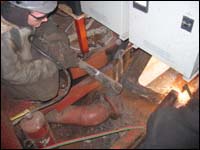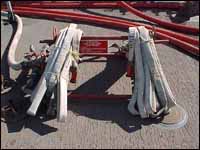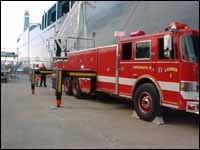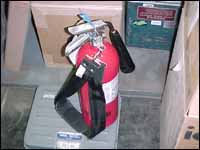Shipyard Employment eTool
Fire Protection >> Fire Watches

Fire watches (Figure 1) are used to prevent and/or extinguish fires at the incipient (beginning) stage. They monitor the hot work sites to ensure that conditions do not change when combustible materials cannot be effectively removed, protected or shielded. Fire watches also require specialized training and are assigned to minimize damage that may be caused by a fire. If a fire occurs, they take appropriate actions to protect all workers.
- Fire watches
- Training. See Fire Protection: Training for specific requirements.

Potential Hazards
- Combustible materials cannot be removed, protected or shielded.
- Climbing ladders with heavy fire extinguishing equipment.
- Possible exposure to welding or toxic fumes.
- Transfer of heat from one space to another or to spaces below.
- Fire in adjacent spaces.
- Coverings used to protect equipment may not be fire retardant.

Requirements and Example Solutions
- For employees performing fire watch activities, a written policy must be created and maintained specifying: [1915.504(a)]
- Each employee must be provided training, including detailed fire watch requirements. [1915.504(a)(1)]
- Duties to be performed. [1915.504(a)(2)]
- Equipment to be used. [1915.504(a)(3)]
- Personal protective equipment (PPE) required to be made available and worn. [1915.504(a)(4)]
-
A fire watch (Figure 2) must be posted during hot work when any of the following conditions are present: [1915.504(b)]

- Slag, weld splatter, or sparks might pass through an opening and cause a fire (Figure 3). [1915.504(b)(1)]
- Fire-resistant guards or curtains are not used to prevent ignition of combustible materials on or near decks, bulkheads, partitions, or overheads. [1915.504(b)(2)]
- Combustible material closer than 35 feet to the hot work cannot be removed, protected with flame-proof covers, or shielded with metal or fire-resistant guards or curtains. [1915.504(b)(3)]
- Hot work is performed on or near insulation, combustible coatings, or sandwich-type construction that cannot be shielded, cut back, or removed, or in a space within a sandwich type construction that cannot be inerted. [1915.504(b)(4)]
- Combustible materials adjacent to the opposite sides of bulkheads, decks, overheads, metal partitions, or sandwich-type construction may be ignited by conduction or radiation. [1915.504(b)(5)]
- Hot work is close enough to cause ignition through heat radiation or conduction on: [1915.504(b)(6)]
- Insulated pipes, bulkheads, decks, partitions, or overheads (Figure 4). [1915.504(b)(6)(i)]
- Combustible materials and/or coatings. [1915.504(b)(6)(ii)]
- Work is close enough to unprotected combustible pipe or cable runs to cause ignition. [1915.504(b)(7)]
- A Marine Chemist, a Coast Guard-authorized person, or a shipyard Competent Person requires that a fire watch be posted. [1915.504(b)(8)]
-
A fire watch must not be assigned to other duties while hot work is in progress. [1915.504(c)(1)]

- A fire watch must: [1915.504(c)(2)]
- Have a clear view of and immediate access to all areas included in the fire watch. [1915.504(c)(2)(i)]
- Be able to communicate with workers exposed to hot work. [1915.504(c)(2)(ii)]
- Be authorized to stop work if necessary and restore safe conditions within the hot work area. [1915.504(c)(2)(iii)]
- Remain in the hot work area for at least 30 minutes after completion of the hot work unless the employer or its representative surveys the exposed area and makes a determination that there is no further fire hazard. [1915.504(c)(2)(iv)]
- Be trained to detect fires that occur in areas exposed to the hot work. [1915.504(c)(2)(v)]
- Attempt to extinguish any incipient stage fires in the hot work area that are within the capability of available equipment and within the fire watch's training qualifications. [1915.504(c)(2)(vi) and 1915.508]
-
Alert employees of any fire beyond the incipient stage. [1915.504(c)(2)(vii)]

- Activate the alarm if unable to extinguish fire in the areas exposed to the hot work. [1915.504(c)(2)(viii)]
- Be physically capable of performing fire watch duties. [1915.504(c)(3)]
-
Assign additional fire watch in adjacent spaces.

- See Fire Protection FAQs: B-9 for a multiple fire watch solution

- When a fire occurs, attempt to extinguish. If not successful, evacuate space and sound the alarm. [1915.504(c)(2)(vi) and (viii)]
- Fire watch should ensure that protective covers remain in place and watch where sparks are flying.
- Have appropriate carrier for fire extinguishing bottles (Figure 8) when climbing ladders.
- Fire watch has appropriate PPE for the condition such as:
- respiratory protection equal to the protection for the welder
- eye protection and shielding allowing them to evaluate the surrounding area
- Use adequate protective covering that is flame-resistant when conducting hot work.
- Train workers to recognize protective coverings that are not fire retardant.
- Label fire retardant coverings for easy recognition.

